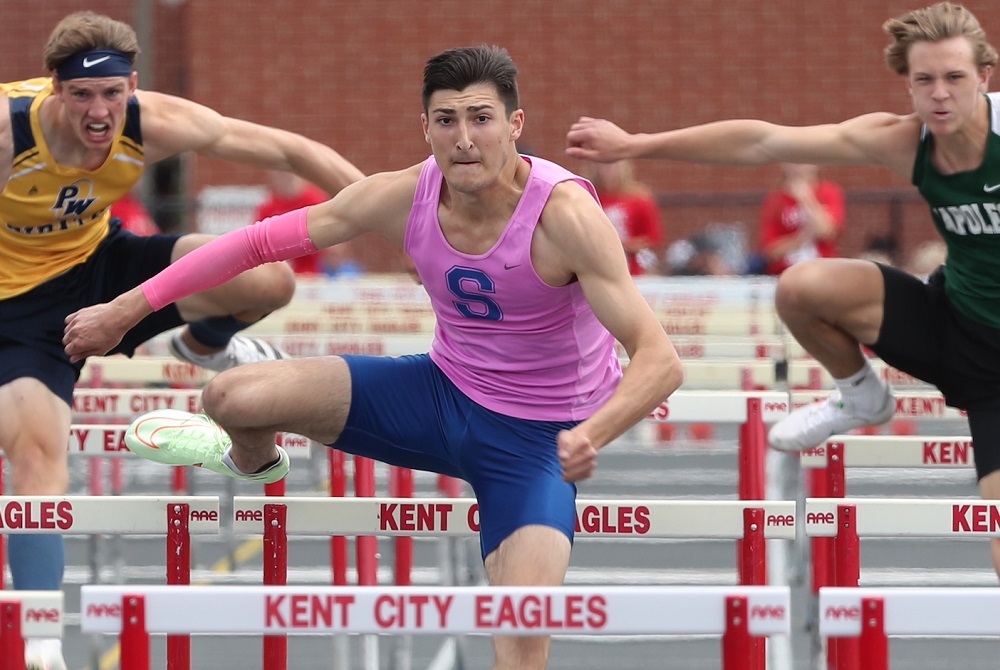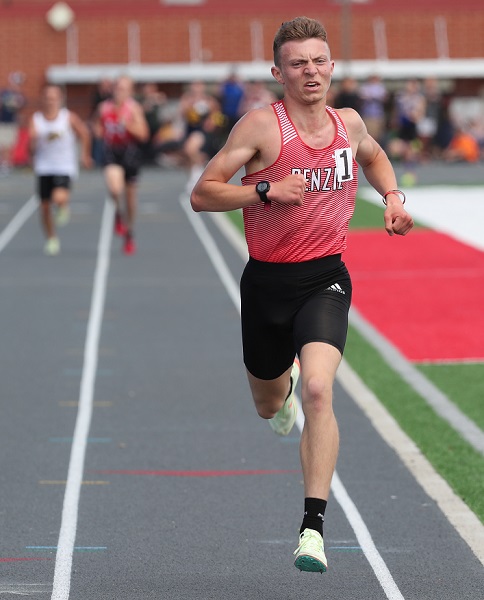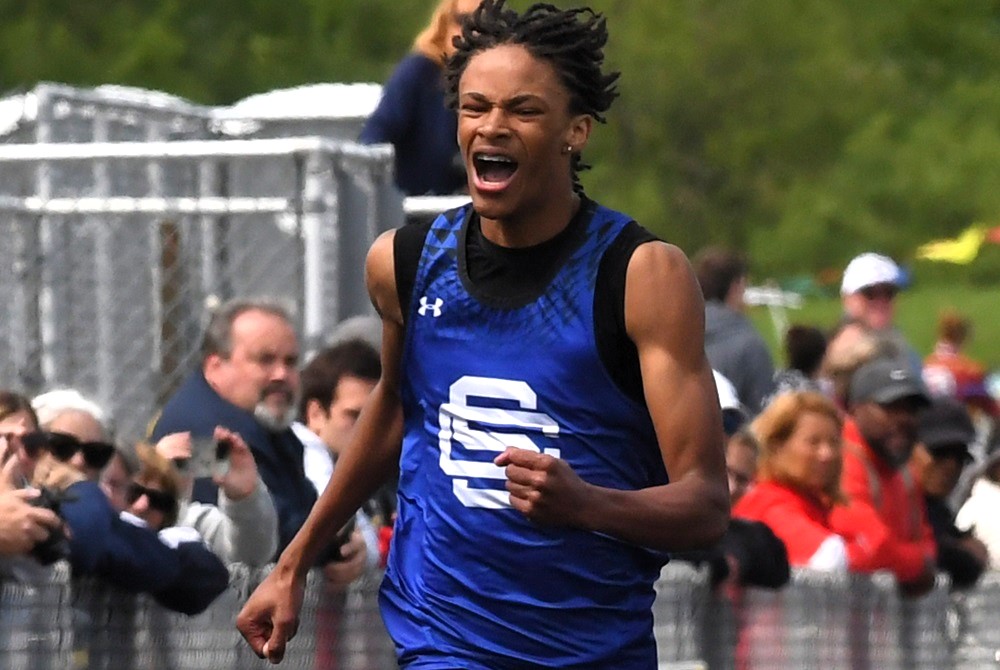
Diaz, Jones Star Again, While Lansing Catholic Follows Standout Pair
By
Scott DeCamp
Special for MHSAA.com
June 4, 2022
KENT CITY – Benny Diaz’ first three races of Saturday’s MHSAA Lower Peninsula Division 3 Track & Field Finals at Kent City High School said a lot about his considerable ability and sheer speed.
His fourth and final race said a lot about his character, even though he didn’t win that one.
The Saugatuck senior blazed to championships in the 110-meter hurdles (13.64 seconds), 100 dash (11.16) and 300 hurdles (39.43) before he pulled up with a hamstring injury near the midway point of the 200 dash.
Diaz, a University of Michigan signee, had a chance to become a four-event winner, but it was not in the cards. After he bent over at the waist and paused on the track, he finished the 200 in a slow trot as the packed stands cheered him to the finish line. He was “slightly upset,” but just wanted to finish the race.
“I’d say it’s better to finish it than to just stop,” Diaz said. “I guess it says a lot about your character. You’re willing to finish things, even if it’s not going so well.”
Diaz’ injury opened the door for Lansing Catholic to capture its second Division 3 team championship, and first since 2012. Lansing Catholic finished with 38 points to edge Saugatuck by a single point.
Led by junior Hunter Jones’ pair of individual titles, Benzie Central placed third with 32 points. Pewamo-Westphalia (30) and Hart (29) rounded out the top five.
Lansing Catholic took first in the final race of the day, the 1,600 relay (3:25.91), to push the Cougars over the top. Senior Josh Otten anchored that winning relay, placed runner-up in the 400 and third in the 1,600, and he anchored the second-place 3,200 relay. Senior Dave Pruder was third in the 800, and he joined Otten on the aforementioned relays that scored valuable points for the Cougars.
“Every one of them came through,” said Lansing Catholic coach Tim Simpson, who also guided the Cougars to the Division 3 title in 2012. “Otten came through with a huge day, Pruder came through with a huge day. Everybody else did their job.”
Jones captured championships in the 800 (personal record 1:52.68) and 1,600 (4:10.68), and he finished second in the 3,200 (9:25.87) to join Diaz as one of the top performers of the meet.
 Jones now has three MHSAA track state titles under his belt, as well as three Division 3 cross country championships. He won the 1,600 at last year’s Finals.
Jones now has three MHSAA track state titles under his belt, as well as three Division 3 cross country championships. He won the 1,600 at last year’s Finals.
“I was comfortable for the mile and the 800 I was strong, but after the 800 I was at the trash can – I wasn’t feeling well,” said Jones, who is close to announcing his college commitment to a Division I school but is keeping that announcement close to the vest.
“My coaches, they helped me out. They helped me gain confidence and I threw myself on the track, got around eight laps and got runner-up (in the 3,200).”
Diaz finishes his storybook high school track career with five total Finals titles, going back-to-back in both hurdles events as a junior and senior.
Hurdles are the specialty for the slender Diaz, a 6-foot-1, 160-pounder, who glides along the track and makes it look effortless.
Seemingly stuck with the pack in the 100 on Saturday, Benny turned on his jets in the final 30 meters and burst to an impressive victory. He said that he tends to be a slower starter and strong finisher.
“Oh, no, it’s like that – it’s like that,” Diaz said with a grin. “I can just be lackadaisical before the start and just, it turns on. I mean, that’s just the type of kid I am, kind of low energy, just chill. Don’t get too high, don’t get too low.
“That’s just my race. I’m usually behind at the start and then I catch up with my top speed – speed and endurance.”
Diaz hobbled to the medal stand after the 200. He attributed the left hamstring injury to nerve problems, which flared up Friday.
He said he didn’t know how the nerve issues started and was hoping it wouldn’t be an issue Saturday.
“I’ve just been managing it. I was trying to keep it a secret, but now it’s kind of out the window,” a smiling Diaz said.
“But, I mean, I’m still happy with 30 points.”
Other individual champions included Sanford Meridian’s Dane Plichta in the 200 (22.82), Richmond’s Evan Green in the 400 (49.79 PR), Manton’s Noah Morrow in the 3,200 (9:17.84), Mason County Central’s Andrew Quinn in shot put (61-1.5 PR), Hart’s Kellen Kimes in discus (165-10 PR), Lake City’s Gavin Bisballe in high jump (6-5), Ovid-Elsie’s Tryce Tokar in pole vault (14-3 PR) and Warren Michigan Collegiate’s Trevon Redding in long jump (22-5).
Other first-place relay teams included Madison Heights Bishop Foley in the 400 (44.38), Sanford Meridian in the 800 (1:30.97), and Traverse City St. Francis in the 3,200 (8:10.56).
Grosse Pointe Woods University Liggett sophomore Jacob Juip competed in the first-time adaptive events in the 100 (57.63) and 200 (2:17.57).
PHOTOS (Top) Saugatuck's Benny Diaz, middle, builds his lead in the 110 hurdles Saturday at Kent City. (Middle) Benzie Central's Hunter Jones sets the pace on the way to one of his two race wins. (Click for more by Carter Sherline/Run Michigan.)

Performance of the Week: Southfield Christian's Brock Morris
June 5, 2025
 Brock Morris ♦ Southfield Christian
Brock Morris ♦ Southfield Christian
Senior ♦ Track & Field
Morris finished an individually-phenomenal day at Saturday's Lower Peninsula Division 4 Finals by helping his teammates make school history. With Southfield Christian trailing leader Kalamazoo Hackett Catholic Prep by three points heading into the final event of the day, Morris anchored the Eagles' 1,600 relay and crossed the finish line first – which, combined with Hackett's third-place finish in the race, gave Morris and his teammates their school's first Finals team championship in track & field by one point.
That victory capped a day that also saw Morris win the 200 and 400-meter open races and run on the winning 800 relay as well. Morris was part of school records in all four of those races this season and the 400 relay as well; the 1,600 relay time of 3:24.36 on Saturday lowered that school record and also included Dylan Taylor-Wilkerson, Robert Brown and Jadon Staten. Morris also ran cross country and played point guard on the boys basketball team. He will study at University of Michigan, majoring in biology, health and society on a pre-medical track.
@mhsaasports 🏃♂️POW: Brock Morris #southfieldchristian #track #finals #winner #1600relay #anchor #part1 #highschoolsports #tiktalk #interview #performanceoftheweek #mistudentaid #fyp #MHSAA ♬ original sound - MHSAA
@mhsaasports 🏃♂️POW: Brock Morris #instagram #chocolatemilk #hidden #talent #emoji #part2 #performanceoftheweek #mistudentaid #fyp #MHSAA ♬ Monkeys Spinning Monkeys - Kevin MacLeod & Kevin The Monkey
Follow the MHSAA on TikTok.
MHSAA.com's "Performance of the Week" features are powered by MI Student Aid, a division within the Department of Lifelong Education, Advancement, and Potential (MiLEAP). MI Student Aid encourages students to pursue postsecondary education by providing access to student financial resources and information. MI Student Aid administers the state’s 529 college savings programs (MET/MESP), as well as scholarship and grant programs that help make college Accessible, Affordable and Attainable for you. Connect with MI Student Aid at www.michigan.gov/mistudentaid and find more information on Facebook and Twitter @mistudentaid.
Previous 2024-25 honorees
May 30: Chloe Qin, Bloomfield Hills Cranbrook Kingswood tennis - Report
May 23: Drew Goik, Bay City Western golf - Report
May 15: Sydney Kuhn, Saginaw Swan Valley track & field - Report
May 8: Ryan Bosch, Fruitport baseball - Report
May 1: Jackson Lam, Kalamazoo Loy Norrix track & field - Report
April 25: Isabelle Horvath, Bangor softball - Report
April 18: Presley Jones, Sterling Heights Stevenson soccer - Report
April 11: Olivia Jasniewicz, Troy soccer - Report
March 27: Katie Spicer, Fowler basketball - Report
March 21: Moses & Markus Blackwell; Warren Lincoln basketball - Report
March 13: Keyshawn Summerville, Lansing Sexton basketball - Report
March 6: Maggie Buurma, Fowlerville wrestling - Report
Feb. 28: Maren Studt, Pontiac Notre Dame Prep skiing - Report
Feb. 21: Olive Krueger, Marquette swimming - Report
Feb. 14: Hunter Lemmon, Fraser swimming - Report
Feb. 7: Aubrey Hillard, Rochester competitive cheer - Report
Jan. 31: Wyatt Spalo, Reed City wrestling - Report
Jan. 24: Olivia Flynn, Harbor Springs basketball - Report
Jan. 17: Levi Rozema, Holland Christian swimming - Report
Jan. 10: McRecco McFadden, Burton Bentley basketball - Report
Dec. 18: Nash Leonard, Bay City Western hockey - Report
Dec. 11: Blake Cosby, Dundee wrestling - Report
Dec. 4: Keaton Hendricks, Zeeland West football - Report
Nov. 29: Kate Simon, East Grand Rapids swimming - Report
Nov. 22: Ella Kokaly, Essexville Garber volleyball - Report
Nov. 15: Caroline Bryan, Grosse Pointe South swimming - Report
Nov. 8: Kaylie Livingston, Whitmore Lake cross country - Report
Oct. 25: Oliver Caldwell, Grand Rapids West Catholic tennis - Report
Oct. 18: Alex Graham, Detroit Cass Tech football - Report
Oct. 11: Victoria Garces, Midland Dow cross country - Report
Oct. 4: Asher Clark, Bay City John Glenn soccer - Report
Sept. 26: Campbell Flynn, Farmington Hills Mercy volleyball - Report
Sept. 19: TJ Hansen, Freeland cross country - Report
Sept. 12: Jordan Peters, Grayling soccer - Report
Sept. 6: Gabe Litzner, Sault Ste. Marie cross country - Report
Aug. 30: Grace Slocum, Traverse City St. Francis golf - Report
(Photo by RunMichigan.com.)

